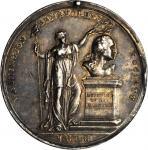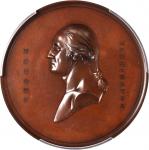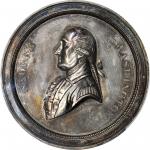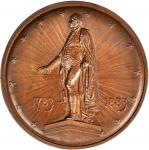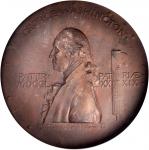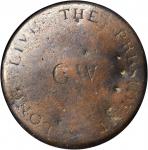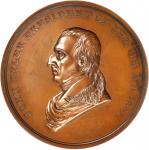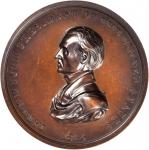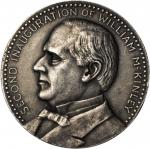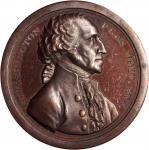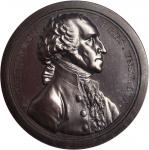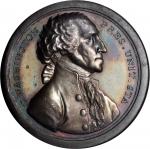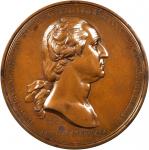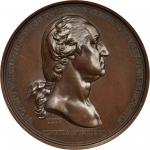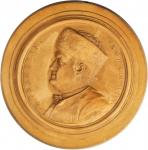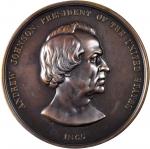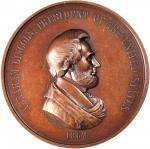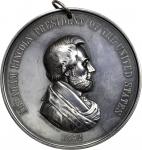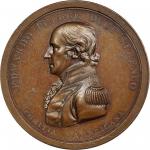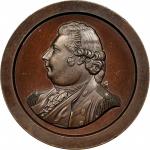1796 (1798) Washington Seasons Medal. The Shepherd. Silver. 48.2 mm. 46.7 grams, 719.3 grains. Musante GW-67, Baker-170, Prucha-37, Julian IP-51. Plain Edge. Specimen-58 (PCGS).Never mounted. An extraordinary specimen of one of the most notable American historical medals. This specimen was among the highlights of our May 2015 Rarities Sale, and we are delighted to be able to once again present it for sale. We describe it here just as we did in our 2015 offering, as the superb condition, history and desirability have not changed in the least for this rare and important historical medal.<p>It was designed by the great John Trumbull and struck in England at the mint of Boulton and Watt from dies by Conrad Küchler. Just 17 specimens of this medal were struck in the silver, unmounted format as offered here. This one remains in high grade, with prooflike fields on both obverse and reverse toned in lovely, subtle pastel blue, rose and gold. Deep gray and navy blue accent the rims. The eye appeal is superb, with excellent color, surface and originality. Only the lightest friction is seen, along with insubstantial handling. Minor hairlines are seen on both sides along with some trivial and shallow light scratches. A small group of contact marks are present in the central obverse field, below the trees overhang. A thin, shallow hairline arcs from near the top of the leaning conifer to the hump of the cow. A single dig is noted on the right upright of N in PRESIDENCY on the reverse; the flaw below the right side of Y is a natural struck-through. A bruise on the edge near 5 oclock is invisible from both obverse and reverse. This piece, given its lack of a mount, is unlikely to have been given to a Native American and instead probably survived in the cabinet of a VIP before being passed to future generations.<p><p>The Seasons medals, dated 1796 and named to the SECOND PRESIDENCY OF GEO:WASHINGTON, as inscribed on the reverse, were struck in 1798 while John Adams was president. They were chiefly distributed during Jeffersons administration, during the travels of Lewis and Clark, among others. Most of the mounted (or formerly mounted) specimens in both copper and silver show significant wear. Those that were never mounted typically survive in fairly high grade, including some that have remained in Gem condition by virtue of inclusion in cased sets; six were produced for Rufus King, the American minister to the Court of St. James, in 1799. One was sold in our (Bowers and Merenas) June 1984 sale of property from the estate of Virgil Brand.<p><p>Any Seasons medal in silver is a great rarity. Though each of the three types had mintages in silver of about 150 pieces with mounts and 17 without mounts (along with fewer in copper), principally copper examples have survived. The creative designs may have been appealing with Enlightenment era Anglo-Americans, but over the course of the previous century, Native Americans had grown accustomed to medals with large portraits of a king on the obverse. It seems likely the Seasons medals were traded in for other medals; it is just as likely that many were melted and never distributed at all. The Ford Collection, far and away the single largest grouping of Indian Peace medals ever assembled, included four silver Seasons medals. Ford II (2004) included a well-worn once-mounted Sower (also known as The Farmer), while Ford XVI (2006) included a mounted Shepherd (undergraded as Choice Very Fine), a mounted Sower (graded Very Fine), and a never-mounted Spinner in similar grade to this one. The Shepherd was the highest priced of them, selling for $57,500 to a well-known dealer.<p><p>The first reference to this medal type comes from an August 8, 1797, letter from the artist John Trumbull to Rufus King enclosing "slight sketches of three subjects for medals, in conformity to the request of the President as expressed to you by the Secretary of War [James McHenry]." The letter calls this design "No. 1" and describes it as follows: "Alludes to the raising of cattle -- a cow licking a young calf -- sheep and a lamb suckling -- a man in the character of a shepherd watching them -- a small house and trees in the distance." Perhaps the most important historical document referring to these medals comes from the journals of Lewis and Clark in an entry from August 17, 1805, which describes the distribution of gifts that day. Cameahwait, the brother of Sacagawea, received a small size Jefferson Indian Peace medal, along with a coat, shirt, scarlet leggings, tobacco, "and some small articles." The entry continues:<p><p>"<em>Each of the other chiefs received a small medal struck during the presidency of General Washington, a shirt, handkerchief, leggings, a knife and some tobacco. Medals of the same sort were also presented to the young warriors who, though not chiefs, were promising youths, and very much respected in the tribe.</em>"<p><p>Though rarer than Jefferson Indian Peace medals, silver Seasons medals enjoy much of the same history but less modern popularity. Most survivors are not aesthetic prizes, but this example offers superlative visual appeal, showcasing Trumbulls design to perfection. It is a museum quality monument to the very earliest efforts at establishing diplomacy between Native Americans and the infant United States.<p>From our May 2015 Rarities Sale, lot 41.


